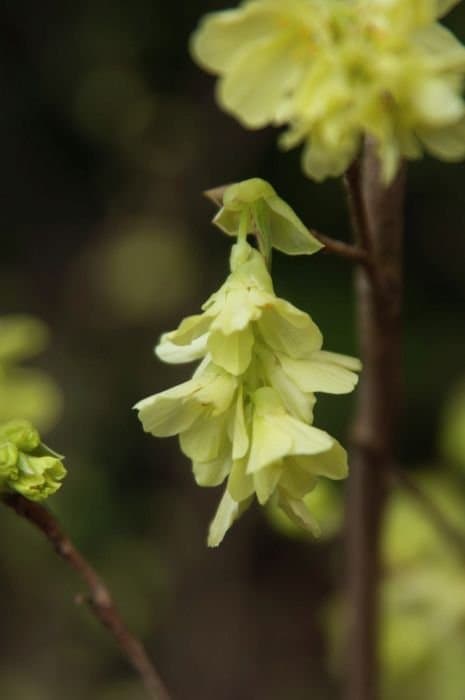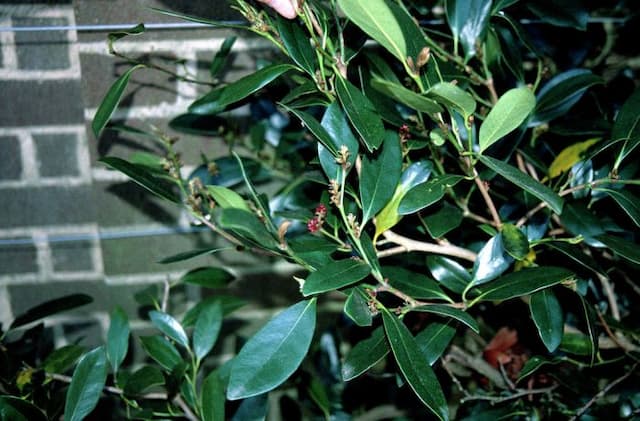Henry's sinowilsonia Sinowilsonia henryi

ABOUT
Sinowilsonia henryi, often referred to as the Chinese parasol tree, is a deciduous plant known for its distinctive appearance. It typically bears large, broad leaves which have an intricate, deeply lobed shape. The texture of the leaves is quite smooth, and they present a lush green color that can bring a vibrant, verdant quality to any landscape setting in which they are present. The flowers of the Chinese parasol tree are equally noteworthy. They usually emerge in clusters, displaying a delicate and somewhat inconspicuous form. These blossoms tend to be small, with their most striking feature being their propensity to appear directly on the branches and older wood of the plant. This form of flowering is known as cauliflory. Consequently, the branches can appear quite ornamental when the plant is in bloom. As the flowers fade, they give way to the fruit of the Chinese parasol tree, which tends to be elongated and can exhibit a color palate that transitions over time. Initially, the fruits may begin with a green hue, reflecting their immature state. As they ripen, they can change to a more pronounced shade that highlights their presence among the foliage. The fruits are typically dry rather than fleshy and may persist on the tree even after the leaves have fallen, adding a layer of interest in the barren winter landscape.
About this plant
 Names
NamesFamily
Hamamelidaceae
Synonyms
Henry's Sinowilsonia
Common names
Sinowilsonia henryi.
 Toxicity
ToxicityTo humans
Sinowilsonia henryi, commonly known as the Henry's sinowilsonia, is not well-known for its toxicity to humans. If you believe that someone has ingested this plant and is showing symptoms of poisoning, it is essential to seek medical advice. However, the lack of information suggests that it may not be commonly recognized as a hazardous plant. Always exercise caution and avoid ingesting plants unless they are known to be safe.
To pets
Henry's sinowilsonia is not specifically documented for its toxicity to pets. However, as with any plant, it is advisable to prevent pets from ingesting it, particularly if the toxicity of the plant is unknown or not well-documented. If you suspect your pet has ingested any part of the plant and is showing signs of illness, contact your veterinarian immediately for advice. It is always better to err on the side of caution when it comes to the potential toxicity of plants to pets.
 Characteristics
CharacteristicsLife cycle
Perennials
Foliage type
Deciduous
Color of leaves
Green
Flower color
Yellow
Height
15-20 feet (4.5-6 meters)
Spread
10-15 feet (3-4.5 meters)
Plant type
Tree
Hardiness zones
6
Native area
China
Benefits
 General Benefits
General Benefits- Ecosystem support – Sinowilsonia henryi provides habitat and food for various species of insects and birds.
- Landscape enhancement – The plant offers aesthetic value to gardens and parks with its attractive foliage and form.
- Shade provider – It can be used in landscaping to provide shade due to its size and dense canopy.
- Soil improvement – Its leaf litter can contribute to soil fertility through decomposition, adding organic matter.
- Erosion control – The root system of Sinowilsonia henryi can help stabilize the soil and prevent erosion.
- Biodiversity promotion – It can help increase plant diversity in cultivated landscapes.
- Seasonal interest – The plant may have different visual interests throughout the seasons, such as changing leaf color or flowering.
 Medical Properties
Medical PropertiesThis plant is not used for medical purposes.
 Air-purifying Qualities
Air-purifying QualitiesThis plant is not specifically known for air purifying qualities.
 Other Uses
Other Uses- Sinowilsonia henryi, commonly known as Henry's Sinowilsonia, can be used as a natural dye source for textiles, providing subtle colors when treated with different mordants.
- The wood of Henry's Sinowilsonia might be used in fine woodworking projects, as it is relatively uncommon and could add an exotic touch to crafted items.
- Its branches may be used in floral arrangements for their visual appeal, lending an unusual and distinctive flair to bouquets and indoor decor.
- The dried seeds of the plant could potentially be used in ornamental crafts, such as in making jewelry or decorative items.
- Henry's Sinowilsonia's large leaves can serve as an ecological wrapping material in place of paper or plastic, for wrapping small items in a sustainable fashion.
- The fibrous material from the bark could be explored as a raw material for hand-made paper production, catering to artisanal paper crafts.
- Henry's Sinowilsonia, when planted, can act as a living fence or privacy screen due to its potential to grow into a dense shrub.
- The plant's ability to grow in a shrubby form may make it suitable for use in hedge mazes or other landscape architecture designs.
- Its unique seedpods could be utilized as biodegradable containers for starting other seeds in a nursery setting before transplanting.
- As a relatively rare plant, Henry's Sinowilsonia could be cultivated for educational purposes, to study and display as part of biodiversity and conservation programs.
Interesting Facts
 Feng Shui
Feng ShuiThe Henryi Sinowilsonia is not used in Feng Shui practice.
 Zodiac Sign Compitability
Zodiac Sign CompitabilityThe Henryi Sinowilsonia is not used in astrology practice.
 Plant Symbolism
Plant Symbolism- Rarity: Since Sinowilsonia henryi, commonly known as the Henry's Sinowilsonia, is not well-known and quite rare, it may symbolize uniqueness or the value of being exceptional.
- Adaptation: This plant has adapted to specific growing conditions in China, which can symbolize the ability to thrive in specialized or niche environments.
- Perseverance: Henry's Sinowilsonia is able to grow in hardiness zones, representing the ability to persist through challenges.
- Elegance: With its attractive flowers and foliage, the plant can be seen as a symbol of natural beauty and grace.
 Water
WaterHenry's yellowhorn should be watered moderately when the top inch of soil feels dry to the touch. In general, this may mean watering approximately once a week, providing about one to two gallons of water each time, depending on the size of the tree and environmental conditions. Over-watering can be harmful, so ensure proper drainage and allow the soil to partly dry between waterings. During the active growing season in spring and summer, you may need to water more frequently, whereas in the winter, when the plant is dormant, watering should be reduced.
 Light
LightHenry's yellowhorn thrives in full sun to partial shade conditions. A spot that receives at least six hours of direct sunlight is ideal for this plant. However, it can tolerate some shade, especially during the hottest part of the day, which can be beneficial in preventing leaf scorch in regions with intense sunlight.
 Temperature
TemperatureFor Henry's yellowhorn, the ideal growing temperatures are between 50°F and 75°F. It can tolerate minimum temperatures down to about 20°F without significant damage, though it has been known to survive brief dips even lower. The plant’s maximum temperature tolerance is around 90°F, but prolonged exposure to temperatures above this can stress the tree.
 Pruning
PruningPruning Henry's yellowhorn is beneficial for maintaining its shape and promoting healthy growth. Pruning should be done in late winter or early spring before new growth starts. Remove any damaged or crossing branches to encourage a strong structure, and thin out dense areas to allow light and air to reach the inner parts of the plant. Pruning can be performed annually or as needed.
 Cleaning
CleaningAs needed
 Soil
SoilFor Henry's sinowilsonia, a well-draining soil mix is essential; combine garden loam, peat, and sharp sand in equal parts. Aim for a soil pH between 5.5 and 7.5, which supports healthy growth.
 Repotting
RepottingHenry's sinowilsonia should be repotted every 2-3 years to refresh the soil and accommodate root growth. Avoid frequent repotting as it prefers to establish itself.
 Humidity & Misting
Humidity & MistingHenry's sinowilsonia thrives best in moderate to high humidity levels, ideally above 50% relative humidity, to mimic its native woodland environment.
 Suitable locations
Suitable locationsIndoor
For indoor Henry's sinowilsonia, ensure bright, indirect light.
Outdoor
Plant Henry's sinowilsonia in dappled shade, shelter from wind.
Hardiness zone
6-9 USDA
 Life cycle
Life cycleSinowilsonia henryi, commonly known as the Henry's Sinowilsonia, is a rare deciduous tree. It begins its life cycle as a seed, which upon germination, grows a small root system and a shoot that emerges from the soil. The seedling stage follows, with the development of true leaves, and the plant enters a phase of rapid growth. As it matures, Henry's Sinowilsonia develops a sturdy trunk and branches, with foliage that provides photosynthetic energy for growth and development. The reproductive stage is marked by the production of small, inconspicuous flowers, which after pollination develop into capsule-like fruits containing seeds. The cycle comes full circle when these seeds disperse, often by wind or animal movement, to begin the process anew in suitable growing conditions.
 Propogation
PropogationPropogation time
Spring to Summer
Sinowilsonia henryi, commonly known as Henry's sinowilsonia, is typically propagated by seeds. The most popular method of propagation for this deciduous shrub is sowing the seeds in the fall shortly after they mature. The seeds should be planted in a well-drained seedbed or in a cold frame. They often require a period of cold stratification to break dormancy, which involves subjecting the seeds to cool temperatures around 40 degrees Fahrenheit (4 degrees Celsius) for several weeks. Once the seeds have been stratified and temperatures begin to warm with the arrival of spring, germination will usually occur. Seedlings can be transplanted to their final growing positions when they are large enough to handle, usually after they have developed a few sets of true leaves.









